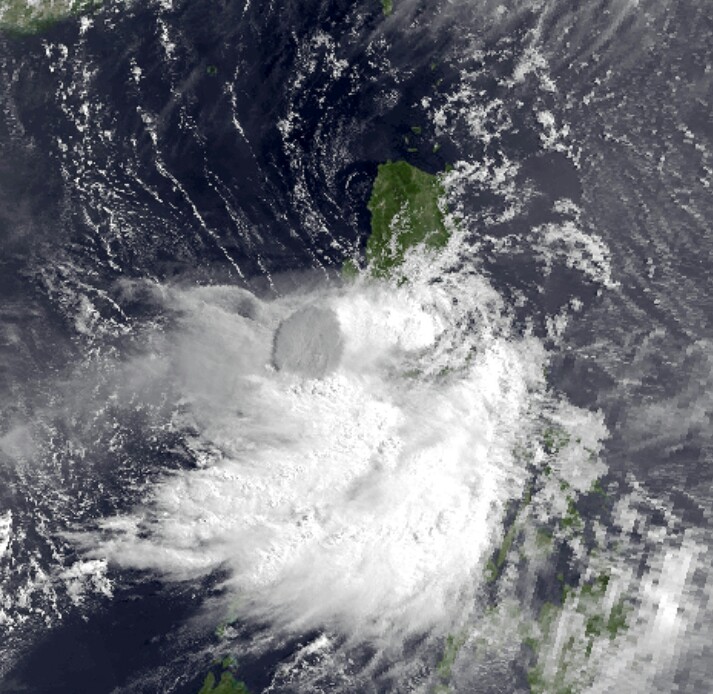Many may still remember the powerful eruption of Mount Pinatubo in 1991. It was one of the largest eruptions in recent history, and sent volcanic ash even as far as Singapore, over 2,400 kilometres (km) away.

But what many do not know is that the thin layer of volcanic ash that had settled across Singapore could have been more severe. Typhoon Yunya (also known as Typhoon Diding) had struck the Philippines almost at the same time as the Mount Pinatubo eruption.

Previously, scientists had not investigated how the typhoon had affected the amount of ash that fell on Singapore. However, preliminary modelling results carried out by scientists at the Earth Observatory of Singapore (EOS) and Asian School of the Environment (ASE) suggest that, had the typhoon not occurred, the impact on Singapore would have been worse. And, in the present day, it would only take a minor ash fall to disrupt incoming and outgoing flights, paralyse Changi Airport, and leave passengers stranded.
While Mount Pinatubo is over 2,400 km away, Singapore sits within one of the most active volcanic regions in the world, with the closest volcano only 400 km away in Sumatra – little is known about the eruptive past of these volcanoes, though evidence suggests their eruptive potential may be significant.

This is an example of a scenario that scientists at the EOS and ASE are currently studying. In particular they are investigating past disasters in the region and how small changes in their circumstances could have led to worse catastrophe, even “Black Swan” events. Popularised by Nicholas Taleb in his book titled The Black Swan: The Impact of the Highly Improbable, the term refers to events that come as a surprise, are very impactful, but are also retrospectively predictable. After all, hindsight is 50/50, is it not?
When you study the past, you very quickly realise that it is littered with near misses of catastrophe. Given the short time-period of recording past disasters, this means that rare “Black Swan” events that could have had large impacts are missing from our past catalogue of events. This results in a serious underestimation of risk. This is especially true in a place like Singapore, which has had limited encounters with natural hazard events in recent past.
So how can these near-misses of “Black Swan” events in our past be included to expand our past catalogue of rare events for which we should prepare for?
To do this, scientists gathered to re-imagine the past through downward counterfactual thinking – imagining how something in the past could have been worse – to try and understand what could have played out differently.
Past disasters are simulated in conditions that differ slightly and their outcomes are assessed. For example, the path of an ash plume from an eruption is modelled based on different wind conditions. Given how wind conditions can change quickly, one can imagine that the areas affected by an ash fall could vary hugely.
Consider, too, what a shift of just a few hours might mean for an earthquake: depending on the time of day, people might be out on the roads, in their office buildings, or at home asleep. This hourly change in occupancy can seriously change the number of lives lost following an earthquake.
Such questions were the central theme of the “Counterfactual Black Swans Workshop” conducted on the 26th and 27th of August 2019 at the Nanyang Technological University (NTU). This research, including the workshop, is funded by the National Research Foundation of Singapore as part of the “Systemic Risk and Resilience Initiative” to help develop Singapore’s capabilities for understanding risk and enhancing resilience.
The workshop was led by Assistant Professor Susanna Jenkins, Assistant Professor David Lallemant, and Research Fellow Yolanda Lin to generate ideas and ways forward to better account for the limited number of observations we have had of extreme natural hazard events.
Scientists from several universities, including NTU, National University of Singapore, University of the Philippines, University of Auckland, Massey University, and University of Bristol, gathered together with industry experts from organisations such as Guy Carpenter and Risk Management Solutions to tackle this challenge.

Already, a number of new projects have emerged from the conclusion of this workshop, including several case studies on past near-miss events for Singapore, integrating additional analytical methods to aid in the counterfactual thought process, and more.
Stay tuned for the upcoming results of these exciting projects!